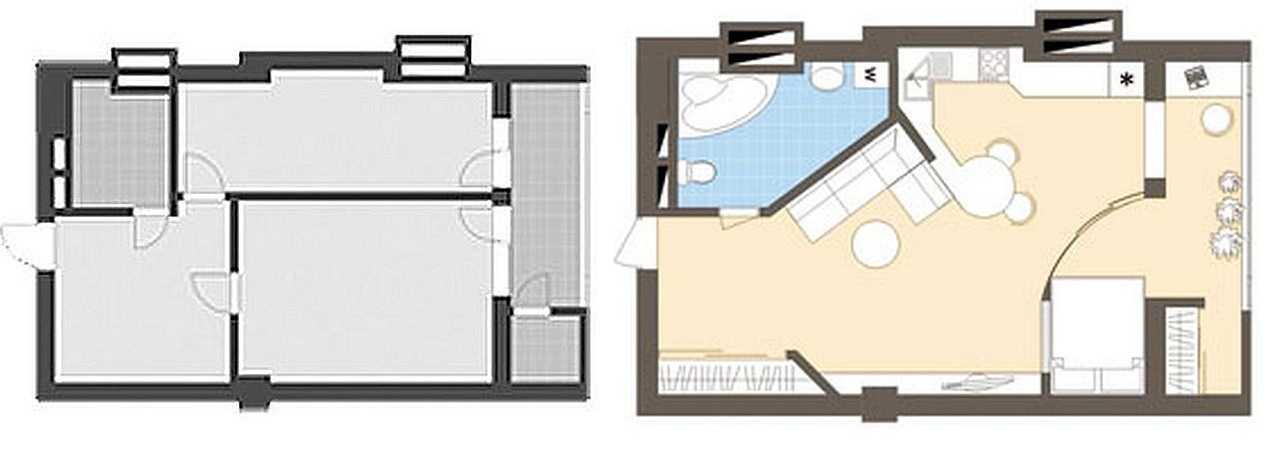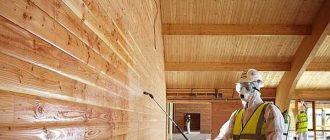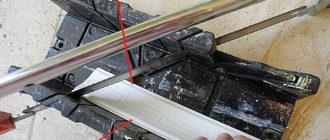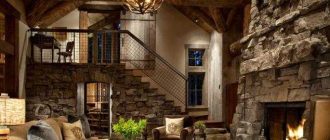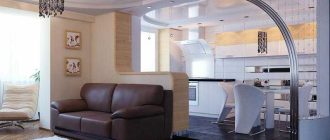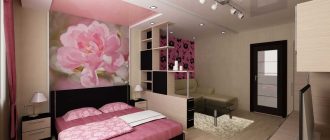One of the tasks of a major renovation is to make the apartment more comfortable and functional. This is achieved by changing the original layout. The article presents options for redevelopment of apartments of different areas, solving different problems.
기사 내용
Types of redevelopment and their harmonization
All types of redevelopment can be divided into several categories. They will differ in the degree of complexity and the number of necessary approving documents. These types are three:
- Redevelopment without prior approval. Documents (the plan of the apartment “before” and after” and a completed application for redevelopment) are submitted to the MFC (multifunctional center) in the introductory order after the completion of the work. Such works include works that do not affect the load-bearing walls:
- Redevelopment according to the project. The BTI orders a plan of the apartment. With it go to the design organization with a permit to SRO, order a redevelopment project. The received project and the application for redevelopment are submitted to the MFC, which is further transferred to the Housing Inspectorate for approval. After obtaining permission, the work is carried out strictly according to the project, at the end of their invited a representative of the Housing Inspectorate, he checks whether the load-bearing walls and building systems have not been affected, gives the Act of acceptance of redevelopment. With this Act and the project, again go to the BTI, get a new technical passport. This type of work includes the dismantling, the device of openings in non-bearing walls, the installation of new partitions that do not create a load on the structure, but specifically:
- Remodeling according to the project with the approval of the author of the house project. In this category fall all interventions in the design of load-bearing walls. With this variant of redevelopment it makes sense to order the project immediately in the organization that developed the serial project of the house, since it will still require their approval. Further the procedure of registration is similar: with documents in the MFC, after repair with the Act of Housing Inspection in the BTI for a new technical passport. The most common types of redevelopment of this type:
- openings in load-bearing walls or floors (transfer or device of new ones);
- kitchen and bathroom relocation;
- making an opening in inter-apartment partitions – bearing or not – it does not matter (in case of merging apartments).
For the last type of redevelopment will require the maintenance of documentation: the Journal of works, drawing up the Acts of concealed works. Also, the work is carried out under the control of the organization that drew up the project. Upon completion of the works, the procedure is the same – receiving the Act and making changes in the BTI.
Variants of redevelopment of a 1-room apartment
In each case, the requirements of the owners of the apartment are different. Everyone has a different lifestyle, habits and preferences about comfort. So that and options for remodeling the same standard project can differ significantly. The most typical, which are found in the vast majority of cases – combining the bathroom, sometimes with an increase in its area, the destruction of storerooms and built-in closets. To them are usually added individual requests that correspond to the needs of the owners.
Allocate a bedroom (from a one-room to make a two-room)
The most common request for remodeling a one-bedroom apartment is to allocate a bedroom. In some variants it is possible, in others it presents difficulties. Presented on the photo of the redevelopment of the apartment in fact 1-bedroom apartment remodels into a two-room apartment. This happens by moving a large number of partitions.
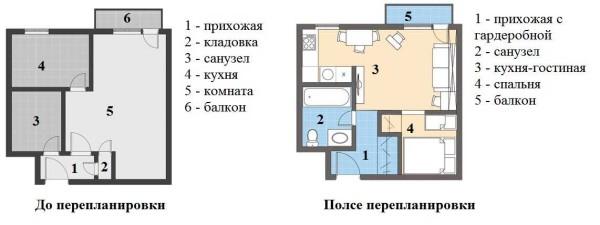
We begin to consider the changes from the entrance. The doors to the bathroom are moved to another wall, the former pantry/wall closet is converted into a dressing room. The area of the hallway has been increased at the expense of the area of the room, and there is a space for a spacious dressing room. Previously, the small hallway had 4 doors, which made its use extremely inconvenient. In the proposed redevelopment option, the functionality of the hallway is much higher.
The partition separating the kitchen is removed, and a partition protecting the bedroom is installed. As a result, we got a kitchen-living room and a separate room for rest. In order to make the separation of the kitchen more obvious, a small partition was put, limiting this zone.
The remodeling did not affect the exit to the balcony. It can be glazed and insulated, after which it can be joined to the room. (Read more about joining balconies here).
Another way is presented in the following project. The original layout is not quite successful: the long, narrow kitchen is clearly inconvenient.
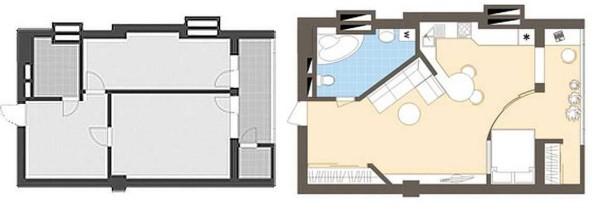
In the process of redevelopment it is necessary to remove the partitions separating the living room and kitchen. The layout of the bathroom has been changed. The area was increased at the expense of the kitchen, but there was room for all the plumbing and washing machine. In the hallway made a small partition, protecting a built-in closet.
The living room area is separated from the kitchen-dining area by a small partition. The separation is supported by a raised dining area, which is a continuation of the large work surface. A window unit has been installed at the exit to the balcony from the former kitchen. It lets in enough light to illuminate the kitchen.
The bedroom is separated from the living room by a partition made of fiberglass, and a translucent sliding radial partition completes the separation. To make the bedroom not too small, the loggia is insulated and glazed. The window unit with the sill part was dismantled, and a wall cupboard was installed in the resulting corner. A workplace is organized at the opposite wall.
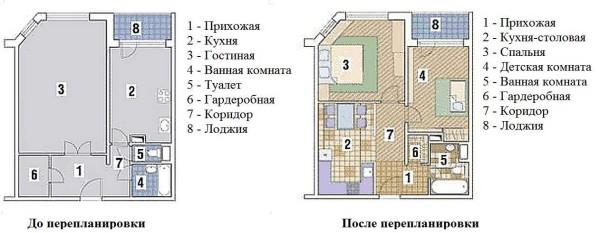
And another layout and its remodeling into a three-room room. More precisely, the rooms remain two, but a studio is formed – a combined kitchen and dining room. This idea is radical – the kitchen is transferred to the place of the living room. The variant can be agreed, only on condition of installation of an electric stove, as well as the presence of technical capabilities to transfer the sewer risers and ventilation.
In this variant, the bathroom is combined, the kitchen is moved into the room, and the kitchen is replaced by a nursery. The former living room is divided into a bedroom, and a significant part of it is moved to the kitchen. The checkroom has also been dismantled – it is also included in the kitchen area. The corridor has become larger, which makes it possible to make all the separated rooms separate. An ambiguous option, but possible.
Turning into a studio (3 variants)
Among young people, the idea of turning a standard apartment into a studio apartment is very popular, in which only the bathroom is burned out. There may also be partitions that partially separate one zone from another. They can be from ceiling to floor, but do not completely block the entire passage, leaving the space unified.
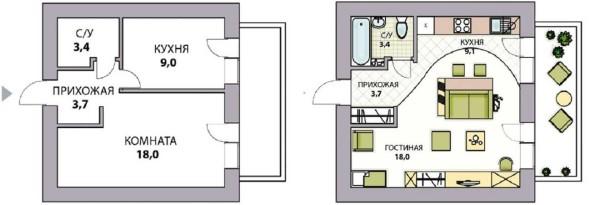
All that is needed in the first option is to tear down the partition between the kitchen and the room. The kitchen area visually finish will be different flooring – in the kitchen – tile, in the dining-living room laminate. Also the divider will be a high table / bar counter, back to which will be a sofa.
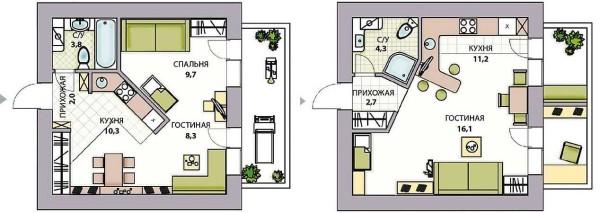
The second proposed method of redevelopment involves the demolition of the partition between the kitchen and the room, as well as separating the hallway from the room. The hallway is only slightly marked by a small partition separating the kitchen area. In place of the demolished walls, a new partition wall has been installed at an angle. It partially encloses the bedroom area, forming the kitchen area.
And the last proposed project involves changing the shape of the bathroom. A partition separating the hallway with a built-in closet is also installed. In the general space of the studio apartment, the kitchen area is separated by a bar counter, all the others are formed only by interior solutions.
Allocation of a nursery
With this layout, there is no special choice. Only to divide the room with a transparent partition that transmits light.
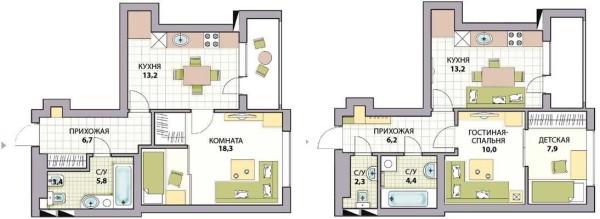
At the request of the owners, the combined bathroom is divided into a toilet and a bathroom. This was made possible by destroying the wall cabinet. Also removed the closet that goes out into the room, moved the entrance to it. Now it is from the corridor, not from the kitchen, as it was before. The part of the room from the window is separated by a plasterboard partition with a sliding door. In the children’s room there is room for a built-in closet. The pass-through room is the living room and the parents’ bedroom.
Remodeling of 2-room apartments
With two-room apartments, there are usually more options: after all, the area is larger, respectively, they provide more room for fantasy.
Make a two-bedroom apartment into a three-bedroom
Having a two-bedroom apartment often want to make it a three-room apartment. In the proposed variant below, the far long and narrow room with a built-in closet is divided into two. And the partition is made non-linear, which made it possible to organize two closets for storing clothes.
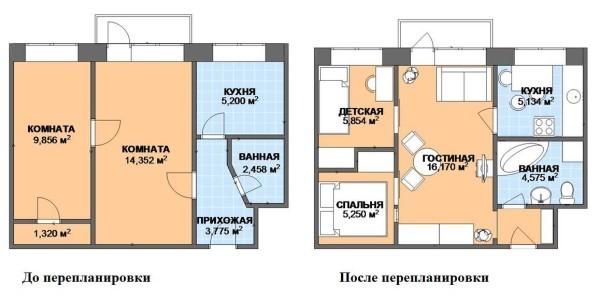
Also, the remodeling affected the area of the bathroom. It is enlarged at the expense of the corridor. The area became almost twice as large, which allowed the installation of a washing machine. Since the entrance to the kitchen from the corridor was blocked, it was made from the living room.
A different type of original layout and a different approach. Strictly speaking, the rooms remained two, but there were two zones – living room and dining room. As a result, the rooms turned out to be separate and both can be used as bedrooms – one for adults and one for children. At the same time, the family will have a spacious room where everyone can gather.
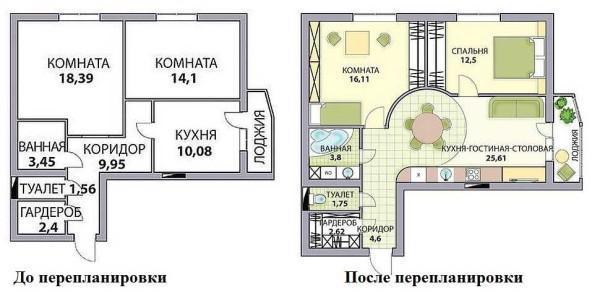
The plus of this plan for remodeling a two-room apartment is also that in both rooms there is an opportunity to make wall closets.
Another variant of the layout with far separated rooms. The task is the same: to have three dedicated rooms. If you do not mess with the global transfer of the kitchen and bathroom, then there are two possible options.
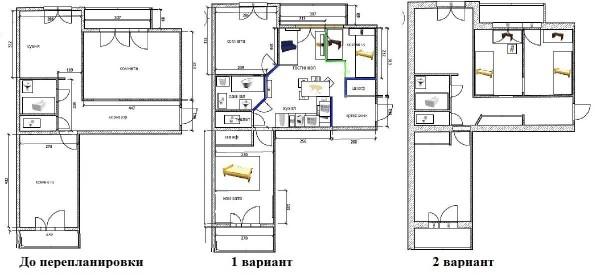
In the first case, remove the partition separating the corridor and the resulting space is divided by partitions (blue color) or translucent partitions (green). In the far room is allocated a closet. The second method is more obvious – dividing a large room into two small ones, dividing the exit to the balcony.
Changing the size of the bathroom and hallway
In many cases, redevelopment concerns the bathroom and hallway. Sometimes increase the size of the hallway by reducing the size of the bathroom, and vice versa. Such options are presented in the photo below.
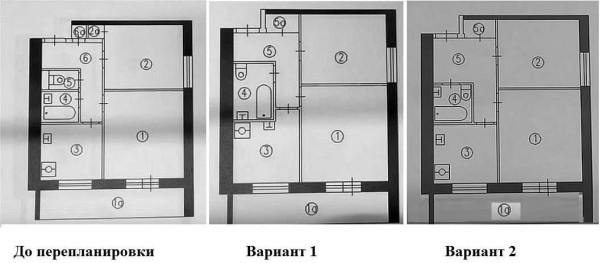
There is another good idea in these plans: two separate wall closets are transformed into one – with an entrance from the hallway.
Changing the size of the rooms
A few more options with a different type of original layout. All that can be done here with the bathroom is to combine it and at the expense of this more rational use of space. The main idea of this redesign is to remove the “appendix” inexplicably sticking out in the room.

As you can see, there are two main options – to make a larger hallway, and the room rectangular or to increase the area of the room, leaving the wall of the hallway in the same place, but removing the built-in closet and moving the partition of the other room. In the second variant it will be possible to arrange a decent-sized dressing room or make two built-in closets – one with an entrance from the hallway, the other – from the room.
Redevelopment of three-room apartments
As in other apartments in 3-room apartments, the main idea is to increase or combine the bathroom, more rational use of the available space. Specific solutions depend on the wishes of the owners.
Optimizing the use of space (at the expense of the corridor)
In the variant shown below, the partition separating the living room from the corridor has been dismantled. The result is a spacious room, which gives space for the realization of various design ideas. Bathroom and toilet are combined, one door is laid. This made it possible to slightly increase the area of the second room.
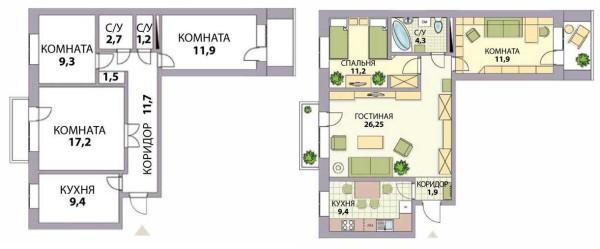
In another project, the size of the corridor is also reduced. This area goes to the living room, but it becomes a passageway, which is not critical for this room. The remodeling also touched the bathroom – the partition between the toilet and the bathroom was removed, and the area was slightly increased by moving the wall into the corridor. At the expense of the same corridor, the kitchen area has been increased – the door unit has been moved almost right up to the entrance to the bathroom.
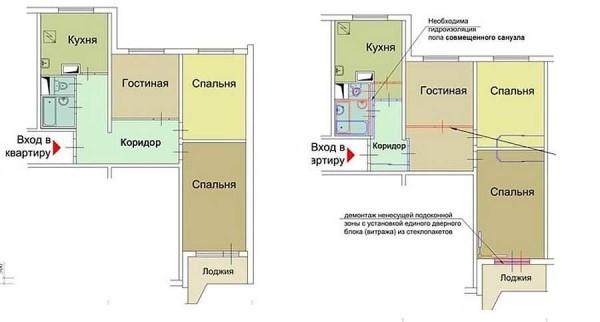
The last remodeling is the removal of the non-load-bearing window sill and the installation of sliding glass doors in the floor instead of the former window unit.
Organization of a second bathroom
In four-room apartments, the area is already large, and there can live quite a lot of people. Therefore, in such cases, they often want to make a second bathroom. The main difficulty is whether there are technical possibilities for water supply and sewerage. It is also not allowed to arrange a bathroom above the living space – only above the technical rooms. In these redevelopment projects, the second bathroom is planned in place of a wall cupboard, which is possible.
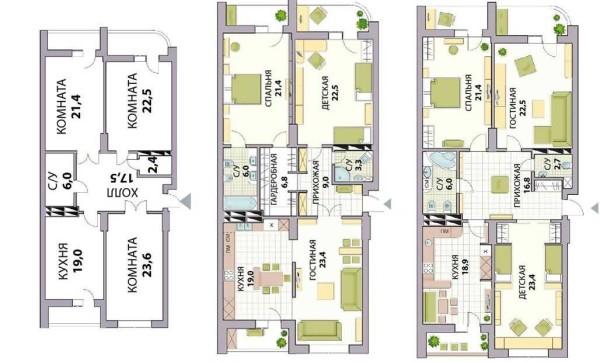
All the main changes concern the use of the hall area, as well as the size of the second bathroom. The purpose of the rooms (all except the kitchen) can also be changed.
Separation of adjacent rooms
Not everyone likes to have passable rooms. The owners of such apartments agree to lose part of the living space, but to divide the rooms. In this case, part of the area of room 2 is fenced off, due to which there is a separation of rooms. The remaining “appendix” can be used as for the device of a wall closet. In this case, the room becomes more regular in shape (closer to the square), which is more convenient for design development.
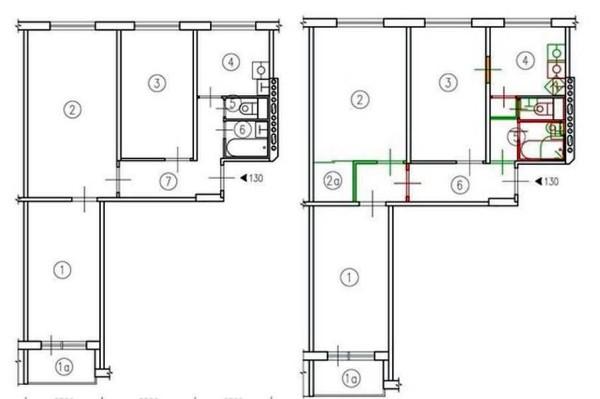
The second group of remodeling concerns the bathroom. Almost all partitions are demolished, the door block to the kitchen is removed. The area of the bathroom becomes larger at the expense of the corridor.
The entrance to the kitchen is made from the living room (room 3). This wall is load-bearing, so the opening requires additional reinforcement with metal structures, as well as the development of the project (as well as the removal of the bathroom into the corridor).

